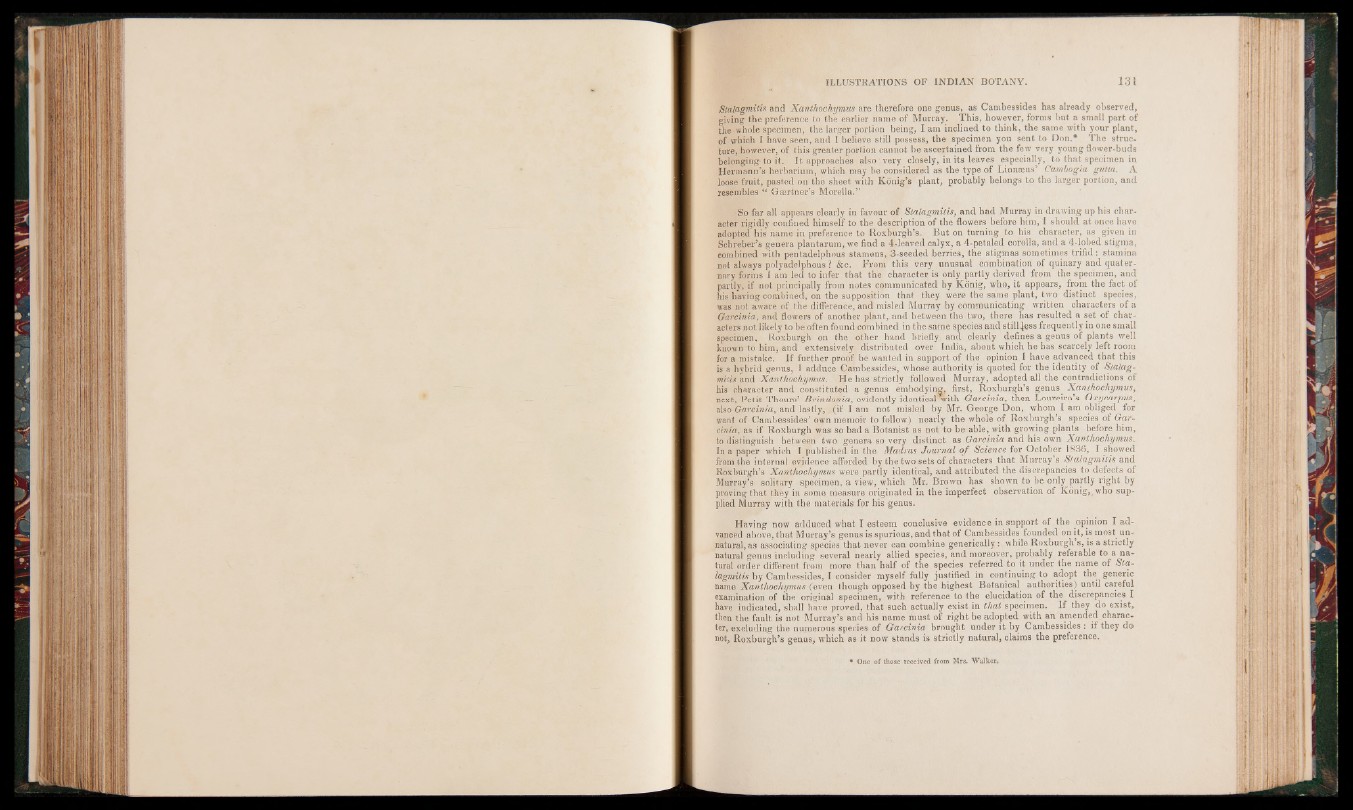
Stalagmitis and Xanthochymus are therefore one genus, as Cambessides has already observed,
giving the preference to the earlier name of Murray. This, however, forms but a small part of
the whole specimen, the larger portion being, I am inclined to think, the same with your plant,
of which I have seen, and I believe still possess, the specimen you sent to Don.* The structure,
however, of this greater portion cannot be ascertained from the few very young flower-buds
belonging- to it. It approaches also' very closely, in its leaves especially, to that specimen in
Hermann's herbarium, which may be considered as the type of Linnaeus9 Cambogia gutta. A
loose fruit, pasted on the sheet with König’s plant, probably belongs to the larger portion, and
resembles “ Geertner’s Morelia.9'
So far all appears clearly in favour of Stalagmitis, and had Murray in drawing up his character
rigidly confined himself to the description of the flowers before him, I should at once have
adopted his name in preference to Roxburgh’s. But on turning to his character, as given in
Schreber’s genera plantarum, we find a 4-leaved calyx, a 4-petaled corolla, and a 4-lobed stigma,
combined with pentadelphous stamens, 3-seeded berries, the stigmas sometimes trifid: stamina
not always polyadelphous ? &c. From this very unusual combination of quinary and quaternary
forms I am led to infer that the character is only partly derived from the specimen, and
partly, if not principally from notes communicated by König, who, it appears, from the fact of
his having combined, on the supposition that they were the same plant, two distinct species,
was not aware of the d iffe ren c e , and misled Murray by communicating written characters of a
Garcinia, and flowers of another plant,, and between the two, there has resulted a set of characters
not likely to be often found combined in the same species and s tilln e s s frequently in one small
specimen, Roxburgh on the other hand briefly and clearly defines a genus of plants well
known to him, and extensively distributed over India, about which he has scarcely left room
for a mistake. If further proof be wanted in support of the opinion I have advanced that this
is a hybrid genus, T adduce Cambessides, whose authority'is quoted for the identity of Stalagmitis
and Xanthochymus. He has strictly followed Murray, adopted all the contradictions of
his character and constituted a genus embodying, first, Roxburgh’s genus Xanthochymus,
next, Petit Thours9 Brindonia, evidently identical with Garcinia, then Loureiro’s Oxy carpus,
also Garcinia, and lastly, (if I am not misled by Mr. George Don, whom I am obliged for
want of Cambessides' own memoir to follow) nearly the whole of Roxburgh's species of Garcinia,
as if Roxburgh was so bad a Botanist as not to be able, with growing plants before him,
to distinguish between two genera so very distinct as Garcinia and his own Xanthochymus.
In a paper which I published in the Madras Journal o f Science for October 1836, I showed
from the internal evidence afforded by the two sets of characters that Murray’s Stalagmitis and
Roxburgh’s Xanthochymus were partly identical, and attributed the discrepancies to defects of
Murray’s solitary specimen, a view, which Mr. Brown has shown to be only partly right by
proving that they in some measure originated in the imperfect observation of König,, who supplied
Murray with the materials for his genus.
Having now adduced what I esteem conclusive evidence in support of the opinion I advanced
above, that Murray’s genus is spurious, and that of Cambessides founded on it, is most unnatural,
as associating species that never can combine generically : while Roxburgh s, is a strictly
natural genus including several nearly allied species, and moreover, probably referable to a natural
order different from more than half of the species referred to it under the name of Stalagmitis
by Cambessides, I consider myself fully justified in continuing to adopt the generic
name Xanthochymus (even though opposed by the highest Botanical authorities) until careful
examination of the original specimen, with reference to the elucidation of the discrepancies I
have indicated, shall have proved, that such actually exist in that specimen. If they do exist,
then the fault is not Murray’s and his name must of right be adopted with an amended^charac-
ter, excluding the numerous species of Garcinia brought under it by Cambessides : if they do
not, Roxburgh’s genus, which as it now stands is strictly natural, claims the preference.
* One of those received from Mrs. Walker,